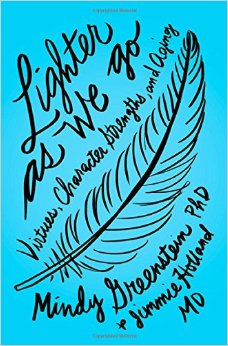
Lighter as We Go: Virtues, Character Strengths, and Aging
By Mindy Greenstein and Jimmie Holland
New York, NY: Oxford University Press, 2015. 285 pp.
ISBN 978-0-19-936095-6 $27.95
Reviewed by Paul T. P. Wong
The authors were absolutely correct in suggesting that “From our different vantage points, we can both see how much society needs an attitude adjustment when it comes to aging” (xiv). The challenge before us is: What would be the most effective way to educate our society to develop a more hopeful and more positive attitude towards aging?
Much of the book’s content is based on the discussions of the Vintage Readers Book Clubs. The authors discovered that group members used “virtues or character strengths as described by the ancient Greeks and repeated in the world’s great philosophical and religious traditions. It was through these virtues and character strengths that they had learned to travel light” (xviii).
The above remark explains why there is little reference to the positive psychology research on virtue and character strengths, even though Peterson and Seligman’s (2004) book was included as part of the Vintage Readers Book Clubs reading list of Harvard Classics.
I make the case that the book is about the dynamic process of meaning making rather than the stable traits of character strengths. The recurrent theme of the book is actually that life becomes lighter as we grow older, only when we learn to accept life in its totality, let go unfulfilled expectations, actively engage in what really matters and appreciate each day as a gift – the four essentials of meaningful living.
Does Well-being Increase With Old Age?
The authors cite research on the U-shaped relationship between age and well-being and seek to answer the question: What enables us to feel better about ourselves in old age, when we are supposed to feel worse because of deteriorating circumstances in health, income and social support?
This is indeed an important question that deserves a sound research answer. However, before we can answer this question, we need to remember that the U-function remains controversial, because there are studies which show decline in well-being among older people in Europe and Latin America (Baird, Lucas, & Donnelian, 2010; Steptoe, Deaton, & Stone, 2014).
More importantly, the variation of well-being in the elderly seems dependent on both their physical health condition (Steptoe, Deaton, & Stone, 2014) and on their ability to adapt to the challenges of old age through meaning making (Wong,1989; Reker & Wong, 2012).
According to the MacArthurs Successful Aging protect led by J.W. Rowe, positive aging is defined in terms of good physical health and productivity in spite of age. Rowe and Kahn (1997) emphasize physical health, cognitive functioning, and active engagement in social and productive activities. Thus, higher well-being is associated with older people who enjoy good physical health and engage in productive activities.
In contrast, the Ontario Successful Aging conducted by Wong and Reker (Wong, 1998; Reker & Wong, 2012) focuses on elderlies’ psycho-social adaptation. They hypothesize that whether well-being will increase and decrease with age primarily depend on whether the seniors are successful in adapting to the challenges of aging.
When many of the major sources of personal meaning, such as work, social status, and activity are diminished in advancing age, the question of ‘Why survive?’ becomes persistent. One’s life satisfaction importantly depends on whether this existential question is answered in the affirmative. Thus, the discovery/creation of meaning through inner and spiritual resources is a promising way of transcending personal losses and despair in old age (Wong, 1998).
In summarizing the Ontario Successful Aging Project, Wong (2014) concludes that successful agers are able to enjoy higher levels of well-being in spite of deteriorations in various domains of life because they have more spiritual resources (religious activities and meaning making), social resources (social and marital relationships), and psychological resources (intelligence, positive attitude and self-reliance). A high level of life satisfaction is achieved only when seniors employ the above resources and apply existential coping strategies of acceptance, meaning making and benefit making.
In light of the above brief literature review, there are already sufficient empirical answers to the well-being question raised in Lighter As We Go. Initially, I was hoping that this book would break new grounds by focusing on more stable personal attributes, such as virtues and character strength in positive aging.
Is the Book about Virtues and Character Strengths?
Judging from the sub-title of the Lighter As We go, the book seems to focus on virtues and character strengths according to the conceptual framework of Peterson and Selgiman (2004). But upon closer examination, the organizational structure of this book seems more like a window dressing.
The book contains three parts: Part I: Character, Character Strength, and Continuity Over Time. Part II: The Virtues. Part III: Putting the Virtues to Work. In Part I. the authors are correct in recognizing the stable, trait-like nature of character. “When we speak of character, we are referring to attitudes that people might be born with or ones that they cultivated” (p.26). They also emphasise the continuity of personality over one’s life span.
However, later in Part 1, the authors acknowledge that virtues are not necessarily universal, and but the products of our struggles for survival. “Character strengths and virtues grow out of life crises” (p.33). This conclusion raises the additional questions: Why do hardships and crises make some people better, and some people bitter? Why is it that adversity leads to character strengths only in some people?
Towards the end of Part 1, they conclude that life is a journey towards meaning – a process of accepting our limitations and discovering who we are and what is meaningful to us. It is “a pursuit that gives each individual life story a sense of integrity and wholeness” (p.62). In short, Part 1 is concerned more about the process of meaning making than the cultivation of virtues and character strengths.
In Part II, the authors do cover most of the character strengths according to Peterson and Seligman’s classification, but do not refer to any research on how these topics are related to life satisfaction in the elderly. Instead, they cover rather extensively Frankl’s concept on meaning and transcendence.
Part III is not really about how to put the virtues to work. The last chapter really deals with death acceptance and the need to celebrate death as part of one’s life cycle. Their last word in the book is captured in this quote: “People who face their mortality in the here and now often have a sense of what their lives have meant to them and wonder what their lives will have meant to the people around them” (p.260). Thus, they seem to suggest that the best approach to overcome aging and dying is to live meaningfully and vitally in light of one’s mortality.
In short, the book is a disappointment for those looking for strength-based positive psychology research on aging; however, it is a helpful dialogue on how to live a life that is meaningful both to self and others.
The Book is All About Meaningful Living in Old Age
According to the above analysis, contrary to their intention, the authors have actually provided strong support to Wong and Reker’s meaning-centered model of positive aging. The following detailed account of several major chapters in the book further illustrate how meaning seems to provide a nexus where virtues, character strengths, psycho-social adaptation intersect, resulting in high levels of life satisfaction in old age.
The chapter on a brief history of aging in the Western World is both interesting and illuminating. According to the authors, throughout history, we have learned two existential lessons: (1) Accepting our limitations as part of the journey and what really matters to us, and (2) accepting the totality of life, both good and bad. Again, these lessons point to the importance of meaning making in adapting to the reality of aging.
The chapter on the virtue of transcendence actually talks about the different ways we can achieve meaning in life through transcending the small “self”, from broadening of self by becoming part of something larger, embracing past meaningful moments through memories, to active engagement in small things with enthusiasm. They conclude that self-transcendence is about meaning making: “Meaning isn’t something that happens to us; it is something we impose on the world around us, making sense of it and finding a fulfilling place for ourselves in it” (p.83).
Likewise, the chapter on the virtue of wisdom is also about the process of learning how not to sweat the small stuff, how not to be too invested in a particular outcome, and how to accept the realities of life.
The wisdom of accepting our mortality is emphasized in the last paragraph of the last chapter. They point out that death is not something to be feared and avoided to the point of getting in the way of living. “Elders live with this reality and often thrive in it.” Intergenerational conversations with younger people would help reduce their fear of aging and dying and increase their ability to live more meaningful and vitally.
Conclusion
The authors have written an excellent book on the adaptive process of achieving a meaningful life in old age. They have expanded on Wong and Reker’s prior research on successful aging with additional insights from broader sources.
While the book is weak in psychology research, it is more than compensated by the rich narratives of positive aging from many seniors and the elegant writing style. I highly recommend this book to Book Clubs for adults and baby boomers.
This book will definitely broaden people’s understanding of aging and dying as the last challenging developmental task. Paradoxically, to age well, one needs to confront death. It will take all the lessons and wisdoms we have learned in order to get through the last stage with sustained growth in courage, meaning and well-being.
References
- Baird, B. M., Lucas, R. E., & Donnelian, M. B. (2010). Life satisfaction across the lifespan: Findings from two nationally representative panel studies. Social Indicator Research, 99(2), 183-203.
- Peterson, C., & Seligman, M. E. P. (2004). Character strengths and virtues: A handbook and classification. New York, NY: Oxford University Press.
- Rowe, J. W., & Kahn, R. L. (1997). Successful Aging. The Gerontologist, 73(4): 433–40. doi:10.1093/geront/37.4.433
- Reker, G. T., & Wong, P. T. P. (2012). Personal meaning in life and psychosocial adapation in the later years. In P. T. P. Wong, The human quest for meaning: Theories, research, and applications (2nd ed.). New York, NY: Routledge.
- Steptoe, A., Deaton, A., & Stone, A. A. (2014). Subjective wellbeing, health, and aging. The Lancet, 385(9968), 640-648. doi:10.1016/S0140-6736(13)61489-0
- Wong, P. T. P. (1998). Spirituality, meaning, and successful aging. In P. T. P. Wong & P. Fry (Eds.), The human quest for meaning: A handbook of psychological research and clinical applications (pp. 359-394). Mahwah, NJ: Erlbaum.
- Wong, P. T. P. (2014, Spring). Positive aging in Canada. BC Psychologist, 3(2), 16-17.
Cite
Published as Wong, P. T. P. (2015). The positive psychology of aging: character strengths or meaning making? [Review of the book Lighter as we go: Virtues, character strengths, and aging]. PsycCRITIQUES, 60(30). doi:10.1037/a0039376
